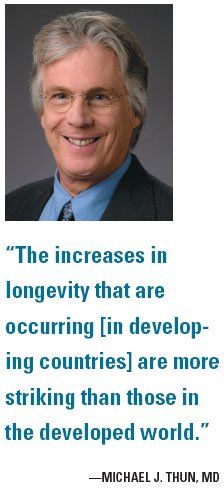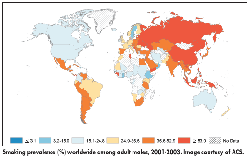ACS expert warns that global burden of cancer will skyrocket without prevention
WASHINGTON, DC-The developing world faces “a tsunami of cancer” without massive tobacco control efforts and programs to stanch infection-related tumors, according to the American Cancer Society’s vice president for epidemiology and surveillance research.
ABSTRACT: East Asia accounted for about one-third of all new cancer cases worldwide in 2007; other countries contend with a rapidly aging population. Michael J. Thun, MD, outlines key opportunities for stemming the cancer crisis.

WASHINGTON, DC-The developing world faces “a tsunami of cancer” without massive tobacco control efforts and programs to stanch infection-related tumors, according to the American Cancer Society’s vice president for epidemiology and surveillance research. Michael J. Thun, MD, discussed global trends in cancer incidence at the 2008 Frontiers of Cancer Prevention Research meeting, sponsored by the American Association for Cancer Research.
“Without prevention, we can be certain that the global burden of cancer will continue to increase extraordinarily rapidly. And most of the increase will be in the developing countries that can least afford new problems,” Dr. Thun said.
A massive demographic shift, mostly in Africa and Asia, is driving the problem, with the number of older adults growing rapidly, Dr. Thun said.
“The increases in longevity that are occurring [in developing countries] are more striking than those in the developed world.” As people survive longer, “there will be a massive increase in the number of cancer cases,” he explained.
In 2007, East Asia, including China, accounted for about one-third of all new cancer cases worldwide. The entire developed world, including North America and Europe, accounted for 17% of new cases, while South Asia, including India, accounted for 11%, Dr. Thun said.
Globally, lung cancer is still the top cancer killer, with stomach cancer second and liver cancer third. All three present key opportunities for prevention, he stressed.

Tobacco control policies could have the biggest impact. In countries that heavily regulate tobacco sales and use, smoking rates continue to decline, Dr. Thun said. “It’s not really a mystery. Smoking prevalence in many of the rich countries continues to decrease. But you see a conspicuous absence of controls in the former Soviet Union and in China and much of East Asia,” areas where smoking rates remain high (see Figure).
After canvassing tobacco control experts, Dr. Thun came up with several strategies that developing nations could implement to decrease their lung cancer incidence and deaths:
• Increase excise taxes to raise the price of cigarettes.
• Enact smoke-free laws to protect nonsmokers from second-hand smoke and to “change social norms about the desirability of smoking.”
• Add warning labels to cigarette packs.
• Increase efforts to prevent cigarette smuggling.
• Offer more smoking-cessation services.
“When these are put in systematically, they work,” he said. Next, Dr. Thun recommended policies for regional control of infection-related cancers. Liver cancer remains a major killer in much of Africa and Asia, with hepatitis B infections causing more than half of all liver cancers. Hepatitis B vaccines are inexpensive, at about $0.60 per person, and readily available. Most countries already require vaccination for infants. “The challenge now is to sustain the infrastructure for [vaccine] delivery, especially in Africa,” Dr. Thun said.
Cervical cancer, meanwhile, is a major concern in Central and Latin America, with human papillomavirus infection as the prime cause. But Pap smear testing “is not affordable in most high-risk countries,” Dr. Thun said. And the new cervical vaccines remain out of reach, costing about $360 per person. Patent protections on the vaccines hold for about another decade, meaning “we’re going to be waiting 30 years before the benefits actually show up for the prevention of cervical cancer, unless two things happen,” he said.
First, the vaccine companies could agree to implement price breaks for developing nations, much as drug companies agreed to do for anti-HIV medications. “Th e alternative is that a country like India begins making the vaccine, breaking the patent, and that’s worse for the [vaccinemaking] companies,” he said. Second, nations with high rates of cervical cancer could increase promotion of condoms and begin visual screening for early cervical cancer with acetic acid testing.
Finally, Dr. Thun recommended continuing Helicobacter pylori eradication trials in countries with high rates of stomach cancer. Despite declining incidence rates worldwide, stomach cancer remains the number two cancer killer, with the countries of former Soviet Union, East Asia, and parts of South America being hot spots.
“Encouraging and supporting these trials wouldn’t preclude the existing screening programs in countries like Japan,” Dr. Thun said. These could help drive down incidence rates and deaths even further.
AACR session chair Christopher P. Wild, PhD, of the University of Leeds in the UK, said that 2002 marked a crossover point, when new cases of cancer in the developing world first outstripped new cases in the developed world. “There’s a real need to focus on prevention now, or else it will be really devastating over the next 30 to 40 years,” he said.